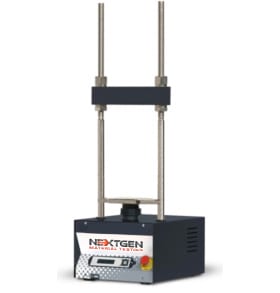
Soil Mechanics Testing Equipment

Standards
EN 12697-34, ASTM D1559, ASTM D5581, AASHTO T245, EN 12697-12, EN 12697-23, AASHTO T193, ASTM D6927
Suitable for CBR, Marshall, indirect tensile, unconfined compression and many other displacement controlled tests.
The new MULTISPEED tester is the ideal solution for Road testing laboratory. The 50 kN capacity and the fully variable test speed of 0.2 to 51 mm/min make it possible to perform not only the CBR and Marshall tests, but many other applications as for instance Indirect Tensile test, Quick Triaxial tests, Unconfined and Uniaxial soil testing and, in general, all test to be performed under displacement control. The machine can be equipped with analogical or digital load/displacement measurement systems as well as with the specific accessories, to suit either the field or central laboratory requirement.
The MULTISPEED tester feature a rigid two column structure with upper cross beam which can be set at various height. The load jack, DC motor and controls are housed in a specially designed base cabinet. When fit in the digital mode, test data is acquired and processed by the Digimax or by other similar instruments.
One of the main features of the new MULTISPEED is the control of test speed which is first easily set and then shown on the display. Furthermore, the test stroke can be set at the beginning of the test with automatic stop, avoiding to overload the machine and the specimen, thus assuring the operator safety. This important feature also permit to perform the speed calibration of the machine by micrometric manual adjustment by the operator. The display also show the travel direction of lower platen. The front panel is also fitted with an emergency button and two operating led: machine switched on and travel direction.
Main Features
- Closed loop speed control
- CBR and MARSHALL test speed can be selected by default.
- Other testing speeds (Custom) between 0.2 and 51 mm/min, can be easily set.
- Selection of maximum platen displacement.
- The automatic stop of the machine avoids machine and specimen overloading, thus assuring operator safety.
- Rapid approach function, to reduce the testing time.
- Rapid platen return to speed up the platen base return at the end of the test.
- Speed calibration function by firmware. The test speed is originally factory calibrated using a polynomial interpolation. A test point is provided to verify the speed with a standard tachometer.
- Emergency stop button as required by the CE prescriptions.
Specifications
| NG-Multispeed | |
|---|---|
| Maximum Capacity | 50 kN |
| Test Speed | Infinitely variable: 0.2 to 51 mm/min |
| Power | DC motor 750 W |
| Horizontal Clearance | 270 mm between columns |
| Maximum Vertical Daylight | 730 mm without accessories |
| Platen Travel | 100 mm |
| Overall Dimensions | 39 x 49 x 121 cm |
| Approximate Weight | 65 kg |
| Alphanumeric Display | 2x16 characters |
FAQs
Yes, the MULTISPEED Digital Automatic Universal Tester for Displacement Controlled Tests is designed to adhere to the EN 12697-34 standard, which specifies test methods for determining bituminous mixtures' resistance to deformation and rutting. This standard is critical for assessing asphalt pavement quality and durability, making the tester an essential tool for civil engineering and road construction projects. Its compliance means that the tester can accurately simulate the conditions these materials will face in service, providing reliable data on their performance characteristics.
The tester's ability to perform displacement-controlled tests aligns with EN 12697-34 requirements, offering precise control over test conditions and ensuring reproducible results. Its digital controls and automatic functionalities enhance the efficiency and accuracy of the testing process, making it easier to assess the material's suitability for use on road surfaces under various traffic and environmental conditions. By meeting this standard, the MULTISPEED Digital Automatic Universal Tester for Displacement Controlled Tests provides a robust solution for quality control and research applications in road construction and maintenance.
Click here to learn more about the product or here to receive a personalized quote.
Yes, the MULTISPEED Digital Automatic Universal Tester for Displacement Controlled Tests complies with the ASTM D1559 standard, which outlines the test methods for Marshall stability and flow of bituminous mixtures. This standard is crucial for asphalt pavement construction and analysis, assessing their ability to withstand loads and deformation. The tester's precision in displacement-controlled testing ensures that it meets the specific requirements set forth by ASTM D1559, providing accurate and reliable data on the material's stability and flow properties.
Compliance with ASTM D1559 indicates the tester's capability to perform essential tests for evaluating asphalt mixture's mechanical properties, crucial for road construction and maintenance. Its automated features streamline the testing process, enhancing results reproducibility and making it a valuable tool for verifying that pavement materials meet the necessary quality standards for durability and performance. The tester's adherence to this standard reinforces its utility in civil engineering, offering a dependable solution for assessing asphalt pavement load-bearing capacity and deformation resistance.
Click here to learn more about the product or here to receive a personalized quote.
Yes, the MULTISPEED Digital Automatic Universal Tester for Displacement Controlled Tests complies with the ASTM D5581 standard. This standard specifies test methods for determining asphalt binder creep stiffness and strength using a bending beam rheometer (BBR). Compliance with ASTM D5581 demonstrates the tester's capability to accurately assess the low-temperature properties of asphalt binders, an essential factor in predicting performance under cold weather conditions.
The tester's design allows precise control over test conditions, ensuring ASTM D5581 requirements are met. This includes the ability to maintain constant temperatures and apply displacement in a controlled manner, which is critical for evaluating asphalt binder creep behavior and stiffness accurately. Meeting the ASTM D5581 standard highlights the tester's versatility and its role in enhancing quality control processes for asphalt binder production. In this way, road construction materials can withstand a variety of environmental factors.
Click here to learn more about the product or here to receive a personalized quote.
Yes, the MULTISPEED Digital Automatic Universal Tester for Displacement Controlled Tests meets the AASHTO T245 standard, which details the procedures for determining the resistance of compacted asphalt mixtures to deformation and rutting through the Marshall test. This standard is pivotal in the evaluation of asphalt pavement materials, ensuring they possess adequate strength and durability for road construction and maintenance projects.
The tester's compliance with AASHTO T245 signifies its capability to accurately perform Marshall stability and flow tests. This is essential for assessing asphalt mixture quality and performance. Its automated features facilitate the precise application of load and measurement of displacement, critical for reliable and consistent test results. By adhering to this standard, the MULTISPEED Digital Automatic Universal Tester for Displacement Controlled Tests provides a robust solution for civil engineering professionals to verify that asphalt mixtures meet the required specifications for use in infrastructure development, contributing to the construction of safer and longer-lasting roadways.
Click here to learn more about the product or here to receive a personalized quote.
Yes, the MULTISPEED Digital Automatic Universal Tester for Displacement Controlled Tests meets EN 12697-12 standard. This standard is part of a series that specifies methods for testing bituminous mixtures, specifically focusing on the determination of asphalt mixture stiffness. Compliance with EN 12697-12 indicates the tester's capability to accurately measure asphalt stiffness properties, which is crucial for evaluating the material's performance under load and its resistance to deformation over time.
The tester's precision in displacement-controlled testing aligns with EN 12697-12 requirements, ensuring reliable and repeatable measurements of asphalt stiffness. This is essential for quality control and research purposes, allowing engineers and material scientists to assess how well asphalt mixtures will perform when used in road construction and repair. By meeting the EN 12697-12 standard, the MULTISPEED Digital Automatic Universal Tester for Displacement Controlled Tests demonstrates its essential role in the development and assessment of durable, long-lasting asphalt pavements.
Click here to learn more about the product or here to receive a personalized quote.
Yes, the MULTISPEED Digital Automatic Universal Tester for Displacement Controlled Tests complies with EN 12697-23 standard. The standard focuses on the determination of water sensitivity of bituminous specimens. This is a critical aspect of assessing the durability and longevity of asphalt pavements under moisture and water damage. Compliance with EN 12697-23 guarantees that the tester can accurately evaluate the effect of water on the cohesion and integrity of asphalt mixtures, providing essential data for improving material formulations and pavement designs.
The tester's ability to conduct displacement-controlled tests allows for precise simulation of asphalt mixture deterioration due to water ingress. This capability is vital for identifying mixtures that maintain their performance characteristics in wet conditions, supporting the development of roads resistant to rutting and disintegration over time. By adhering to EN 12697-23, the MULTISPEED Digital Automatic Universal Tester for Displacement Controlled Tests plays a crucial role in enhancing asphalt production quality assurance processes, ensuring that materials used in road construction are capable of withstanding water and moisture challenges.
Click here to learn more about the product or here to receive a personalized quote.
Yes, the MULTISPEED Digital Automatic Universal Tester for Displacement Controlled Tests meets the AASHTO T193 standard, which outlines the methodology for the quantitative determination of asphalt binder elastic recovery using a ductilometer. This standard is essential for evaluating the flexibility and recovery properties of asphalt binders, which are critical for ensuring asphalt pavement performance under varying temperatures and loads.
Compliance with AASHTO T193 indicates the tester's capability to perform tests that assess the asphalt binder's ability to return to its original length after being stretched, a key indicator of its performance under real-world conditions. The tester's precise displacement control and automatic operation facilitate the accurate measurement of elastic recovery. This provides valuable insights into the material's durability and resistance to cracking. By adhering to this standard, the MULTISPEED Digital Automatic Universal Tester for Displacement Controlled Tests supports the development and assessment of high-quality asphalt mixtures, contributing to road surfaces' durability and longevity.
Click here to learn more about the product or here to receive a personalized quote.
Yes, the MULTISPEED Digital Automatic Universal Tester for Displacement Controlled Tests complies with the ASTM D6927 standard. This standard outlines the test method for asphalt mixtures' resistance to deformation and rutting through the Marshall test. Compliance with ASTM D6927 demonstrates the tester's capability to accurately assess the mechanical properties of asphalt mixtures, such as stability, flow, and density, which are critical for verifying the material's suitability for road construction and maintenance.
The tester's design and functionality are tailored to meet ASTM D6927 requirements, enabling precise control over test conditions and ensuring reproducibility of results. Its ability to perform displacement-controlled tests aligns perfectly with the standard's demands for measuring material resistance under specified loads and conditions. It facilitates the development of asphalt pavements that meet high standards of durability and performance by meeting the ASTM D6927 standard.
Click here to learn more about the product or here to receive a personalized quote.
The MULTISPEED Digital Automatic Universal Tester for Displacement Controlled Tests is designed to perform some tests beyond the California Bearing Ratio (CBR) and Marshall tests, showcasing its versatility across different materials testing applications. This includes the capability to conduct indirect tensile tests, which are essential for evaluating asphalt pavement tensile strength, offering insights into their resistance to cracking under traffic loads.
In addition, the tester can perform Quick Triaxial tests, providing valuable information regarding the soil's mechanical properties under simulated stress conditions, similar to those that may be encountered in situ. A further benefit of the Unconfined and Uniaxial soil testing capabilities is the ability to further expand its application in geotechnical engineering, allowing for the assessment of soil strength without lateral confinement, which is critical in understanding how soil behaves under load.
Click here to learn more about the product or here to receive a personalized quote.
Yes, the MULTISPEED Digital Automatic Universal Tester for Displacement Controlled Tests can be customized with a variety of measurement systems and specific accessories. This is to meet the diverse needs of both field and central laboratory testing environments. It offers the flexibility to be equipped with either analogical or digital load/displacement measurement systems, allowing users to select the option that best fits their precision and ease-of-use requirements.
In addition to its adaptability, the tester is available with a range of specific accessories designed to facilitate a range of different tests, which means that specialized applications can be undertaken as required by the tester. It does not matter whether the tester is used to conduct complex soil analyses, evaluate asphalt properties, or perform tests on other construction materials, the tester can be configured to meet the unique demands of each scenario that requires testing.
Click here to learn more about the product or here to receive a personalized quote.
The rigid two-column structure of the MULTISPEED Digital Automatic Universal Tester for Displacement Controlled Tests significantly contributes to the testing accuracy and reliability of the test. This design provides a stable and robust framework that minimizes vibrations and movement during testing, making sure that the applied load and displacement are both precise and consistent. Such stability is crucial when performing tests that require high accuracy levels, as even minor fluctuations can impact test results.
Moreover, the rigidity of the two-column structure ensures that the machine can withstand repeated stresses and strains, maintaining its accuracy and performance over time. Durability is essential for laboratories and testing facilities that operate continuously and rely on consistent, dependable results. The structural design also allows for flexibility in testing a wide range of materials and specimen sizes, further enhancing the machine's utility and reliability across various applications.
Click here to learn more about the product or here to receive a personalized quote.
Housing the load jack, DC motor, and controls in a specially designed base cabinet for the MULTISPEED Digital Automatic Universal Tester for Displacement Controlled Tests plays a crucial role in enhancing the machine's functionality and durability. This design choice not only protects these critical components from external elements and potential damage but also contributes to the tester's overall stability and operational efficiency.
There is a base cabinet that serves as a centralized hub for the machine's operations, making it possible to streamline the control and maintenance of the testing process as the machine runs. By enclosing the mechanical and electrical components within the cabinet, dust, debris, spills, or any other contaminants, can be prevented from entering the cabinet, thereby reducing the possibility of contamination, which can lead to decreased performance and longevity. Furthermore, this arrangement facilitates ease of access for calibration, adjustments, and repairs, ensuring optimal working conditions.
Click here to learn more about the product or here to receive a personalized quote.
When operated in digital mode, the MULTISPEED Digital Automatic Universal Tester for Displacement Controlled Tests manages test data acquisition and processing through advanced instruments like Digimax or other similar devices. This digital operation mode enhances data management efficiency and accuracy by automating test results collection and analysis. The use of such digital instruments allows for real-time monitoring of test parameters, immediate data processing, and the ability to store and retrieve test results efficiently.
The integration of digital technology facilitates a more streamlined testing process, enabling users to conduct tests with increased precision and less manual intervention. It also provides the capability to easily share and compare data across different testing sessions or with other users, improving collaboration and data analysis. Additionally, the digital mode supports advanced features such as graphical displays of test curves, detailed analysis options, and customizable test reports, offering a comprehensive solution for material testing that meets the demands of modern laboratories and research facilities.
Click here to learn more about the product or here to receive a personalized quote.
The test speed control feature in the MULTISPEED Digital Automatic Universal Tester for Displacement Controlled Tests offers significant benefits by allowing users to easily set and monitor the test speed, which is prominently displayed on the device's interface. This capability allows precise control over testing conditions, enabling the adaptation of test parameters to suit specific material characteristics or compliance with various standards.
By precisely controlling test speed, users can replicate real-world conditions more accurately, leading to more relevant and reliable test outcomes. This is particularly significant in material testing, where the speed of applied load or displacement can significantly affect the material's behavior and thus the interpretation of its properties.
Furthermore, the ease of setting and the visibility of the test speed on the display enhance the user experience, reducing errors and increasing testing efficiency. It allows for quick adjustments and real-time monitoring, ensuring test progress. Overall, the test speed control feature contributes to the MULTISPEED tester's versatility and functionality.
Click here to learn more about the product or here to receive a personalized quote.
The automatic stop feature in the test stroke setting of the MULTISPEED Digital Automatic Universal Tester for Displacement Controlled Tests significantly enhances both the safety of the operator and the protection of the machine and specimen. By allowing the test stroke to be preset at the beginning of the test, the machine automatically halts once the specified displacement limit is reached. This prevents any potential overloading.
This feature ensures that tests are conducted within safe and predefined parameters, minimizing the risk of damaging the specimen through excessive force or displacement. It also protects the machine from operating beyond its designed capacity, which could lead to mechanical failure or compromise its longevity. For the operator, this automatic stop mechanism provides an additional layer of safety, reducing the need for close manual monitoring of the test process and the risk of accidents.
Click here to learn more about the product or here to receive a personalized quote.
The display and front panel of the MULTISPEED Digital Automatic Universal Tester for Displacement Controlled Tests are designed to enhance both the usability and safety of the machine. The display shows the travel direction of the lower platen, providing users with clear, real-time information about the machine's movement during testing. This feature is particularly useful for ensuring that the test is proceeding as intended and for making any necessary adjustments during operation.
Additionally, the front panel is equipped with an emergency button, a crucial safety feature that allows the operator to immediately halt the machine in case of an unexpected issue or to prevent potential accidents. This adds an extra layer of security for both the operator and the equipment. Furthermore, two operating LEDs are included on the front panel: one indicating that the machine is switched on and another showing the travel direction. These LEDs offer at-a-glance confirmation of machine status and movement direction, enhancing testing efficiency and safety.
Click here to learn more about the product or here to receive a personalized quote.
The closed-loop speed control in the MULTISPEED Digital Automatic Universal Tester for Displacement Controlled Tests provides a significant advantage by providing precise and consistent control over the test speed throughout the testing process. This system continuously monitors and adjusts the speed to maintain the set value, regardless of load changes or other external factors that might affect operation.
This level of control is crucial for conducting accurate and repeatable tests, as even minor variations in speed can influence test results, especially when assessing materials' behavior under specific conditions. The closed-loop system responds in real time to any discrepancies between the actual and desired speeds, correcting them immediately to ensure the test continues as planned.
By maintaining constant test speeds, closed-loop speed control enhances test outcome reliability, making it easier to compare results across different This feature is particularly beneficial for research and quality control laboratories that require high precision in their testing protocols.
Click here to learn more about the product or here to receive a personalized quote.
The default selection of CBR (California Bearing Ratio) and MARSHALL test speeds in the MULTISPEED Digital Automatic Universal Tester for Displacement Controlled Tests significantly benefits users by simplifying the testing process for these commonly performed tests. With preset speeds optimized for CBR and MARSHALL tests, the machine can enable users to quickly set up and start their tests without the need to make manual adjustments during the testing process.
The purpose of this feature is to ensure that the tests are conducted under standard conditions to promote consistency and reliability in the results. It also saves time and reduces the potential for user error in setting up the test parameters, making the testing process more efficient and user-friendly. For laboratories and testing facilities that frequently perform CBR and MARSHALL tests, this convenience allows for higher test throughput.
Click here to learn more about the product or here to receive a personalized quote.
The ability to easily set custom testing speeds between 0.2 and 51 mm/min in the MULTISPEED Digital Automatic Universal Tester for Displacement Controlled Tests provides significant flexibility for users, enabling the adaptation of the machine to a wide range of testing scenarios and material types. This range of speeds allows precise control of the testing process. It caters to the specific requirements of different tests and standards beyond the preset options for CBR and MARSHALL tests.
A custom speed setting is particularly beneficial for research and development purposes, as the materials may need to be tested under unique conditions or if different testing protocols are being explored, as the materials may need to be tested under unique conditions. It enables the testing of materials at speeds that closely mimic their real-world application or failure modes, providing insights into their behavior under various stress rates.
Click here to learn more about the product or here to receive a personalized quote.
The rapid approach function in the MULTISPEED Digital Automatic Universal Tester for Displacement Controlled Tests significantly reduces testing time. This is done by quickly bringing the platen close to the specimen before the actual test begins. This feature minimizes the distance the platen needs to travel at the slower, test-specific speed, thus speeding up the overall testing process.
By eliminating the need for the platen to slowly approach the specimen from a greater distance, the rapid approach function allows for more efficient use of testing time. This enables a quicker transition to the critical phase of the test where precise speed and displacement control are necessary. This efficiency is particularly beneficial in high-volume testing environments or when multiple tests need to be conducted in a limited timeframe, enhancing laboratory throughput and productivity.
Furthermore, this function not only saves time but also reduces wear on the machine's components, contributing to the tester's longevity and reliability. The rapid approach feature underscores the MULTISPEED Digital Automatic Universal Tester's design focus on user convenience and operational efficiency.
Click here to learn more about the product or here to receive a personalized quote.
The purpose of the rapid platen return feature in the MULTISPEED Digital Automatic Universal Tester for Displacement Controlled Tests is to significantly speed up the process of returning the platen base to its starting position at the end of a test. This functionality greatly enhances consecutive testing processes by reducing downtime between tests. After a specimen has been tested and the required data collected, the rapid platen return allows the testing apparatus to be quickly reset to its initial position. This is ready for the next specimen without unnecessary delays.
This feature is especially valuable in high-volume testing environments where time efficiency is crucial, allowing more tests to be conducted within a given period. It not only saves time but also improves the overall workflow in the laboratory, enabling technicians to focus on test setup and analysis rather than waiting for mechanical adjustments. By minimizing the turnaround time for each test, the rapid platen return feature directly contributes to increased productivity and operational effectiveness in material testing applications.
Click here to learn more about the product or here to receive a personalized quote.
Factory calibration of the MULTISPEED Digital Automatic Universal Tester for Displacement Controlled Tests using polynomial interpolation guarantees the highest level of accuracy and reliability in test speed from the outset. This advanced calibration method mathematically models the machine's speed characteristics, allowing precise control and adjustment across its operating range. The initial calibration guarantees that the tester operates within tight tolerances, resulting in inconsistent and reproducible test conditions.
The inclusion of a test point for speed verification with a standard tachometer provides an additional layer of reliability and trust in the machine's performance. This feature allows users to periodically check the tester's speed accuracy against a known standard. As a result, it guarantees that the machine continues to operate as intended over time. This capability is particularly critical for maintaining test results' integrity, as even slight speed deviations can significantly affect displacement-controlled tests.
Together, these features underscore the commitment to quality and precision in the design of the MULTISPEED Digital Automatic Universal Tester for Displacement Controlled Tests. By enabling easy verification of the machine's speed accuracy and ensuring it remains within specification, users can have confidence in their test results.
Click here to learn more about the product or here to receive a personalized quote.
The MULTISPEED Digital Automatic Universal Tester for Displacement Controlled Tests is designed with a maximum testing capacity of 50 kilonewtons (kN). This significant capacity allows the tester to apply a wide range of forces during materials evaluation, making it suitable for a broad range of testing applications. From testing the tensile strength and compressive resilience of construction materials like concrete and asphalt to examining the structural integrity of composites and the compaction properties of soils, this capacity supports the tester's applicability across numerous fields including civil engineering, materials science, and quality control in manufacturing.
The 50 kN capacity is crucial for simulating real-world conditions where materials are subjected to high stress and loads, providing accurate insights into their behavior under such circumstances. It enables researchers and professionals to rigorously assess material properties, making sure that only materials meeting the highest standards are used in construction and manufacturing. This level of testing capability is essential for ensuring the safety, durability, and longevity of materials used in infrastructure and industrial applications, contributing significantly to the advancement of material science and engineering practices.
Click here to learn more about the product or here to receive a personalized quote.
The MULTISPEED Digital Automatic Universal Tester for Displacement Controlled Tests offers a wide and infinitely variable range of test speeds, from 0.2 to 51 mm/min. This flexibility in speed adjustment allows for precise control over the testing process, making it suitable for a diverse array of testing protocols across different materials and standards. Whether conducting slow strain rate tests to assess creep behavior in metals or performing rapid loading tests on concrete for compressive strength evaluation, this range ensures that the tester can be tailored to meet specific testing requirements.
The ability to finely adjust the test speed enhances the tester's applicability in research, development, and quality control environments, enabling users to simulate various operational conditions materials might face in real-world applications. This feature is particularly valuable in sectors such as civil engineering, materials science, and manufacturing. Understanding material behavior under different loading rates is crucial for predicting performance and guaranteeing reliability. The tester's wide speed range underscores its versatility and effectiveness as a tool for comprehensive material testing.
Click here to learn more about the product or here to receive a personalized quote.
The MULTISPEED Digital Automatic Universal Tester for Displacement Controlled Tests is equipped with a DC motor with a power specification of 750 watts. This powerful motor enables the tester to perform a wide range of tests by providing the necessary force and speed control required for accurate material testing. The 750 W DC motor makes sure that the tester can maintain consistent test speeds and apply significant loads, essential for evaluating the mechanical properties of various materials.
This motor's power capacity is critical for the tester's ability to conduct tests with high precision, from slow-paced tests that assess material fatigue over time to rapid-loading tests that determine immediate stress responses. The inclusion of such a robust motor enhances the tester's reliability and performance, making it suitable for demanding testing environments in laboratories and industrial settings where materials must be evaluated under strict conditions to ensure their quality and suitability for use.
Click here to learn more about the product or here to receive a personalized quote.
The MULTISPEED Digital Automatic Universal Tester for Displacement Controlled Tests features a horizontal clearance of 270 mm between its columns. This clearance space is specifically designed to accommodate a wide variety of test specimens, providing sufficient room for placing and securing materials of different sizes and shapes for testing. The 270 mm gap ensures that the tester can be used in a broad range of applications. This includes testing small-scale samples for larger materials that require more space.
This spacing is crucial for assuring that the tester can adapt to diverse needs across different industries. These industries include construction, materials science, and engineering. It allows for flexibility in testing protocols and facilitates the easy setup and removal of test specimens, enhancing the efficiency of the testing process. The thoughtful design of the horizontal clearance emphasizes the tester's versatility and commitment to meeting professional testing environments' practical requirements.
Click here to learn more about the product or here to receive a personalized quote.
The maximum vertical daylight of the MULTISPEED Digital Automatic Universal Tester for Displacement Controlled Tests, when not equipped with accessories, is 730 mm. This measurement indicates the maximum vertical space available between the upper and lower platens, providing ample room for accommodating a wide range of test specimens of varying heights. The generous vertical daylight ensures that the tester can be used for experiments requiring significant separation between the platens, such as testing tall specimens or conducting tests that involve substantial deformation or elongation.
This feature is particularly beneficial for testing materials under conditions that mimic their intended use, where vertical space is critical. It allows for increased flexibility in test setup and the ability to adapt to a variety of testing scenarios, making the tester an invaluable tool in laboratories and research facilities that work with diverse materials and testing standards. The 730 mm maximum vertical daylight enhances the tester's versatility.
Click here to learn more about the product or here to receive a personalized quote.
The platen travel distance in the MULTISPEED Digital Automatic Universal Tester for Displacement Controlled Tests is 100 mm. This specification indicates the total vertical movement the platen can achieve during a test, allowing for a wide range of displacement-controlled testing scenarios. The 100 mm travel distance is essential for conducting tests that require significant movement to assess material behavior under stress, such as compression, flexure, or tensile tests.
Due to this travel distance, it is possible to accommodate a variety of materials and testing protocols with a high degree of flexibility. As a result, the tester can effectively be used in a wide range of applications, thereby ensuring a wide range of potential applications. Whether evaluating the compressive strength of concrete, the tensile properties of metals, or the flexural characteristics of composites, the 100 mm platen travel guarantees that the tester can meet diverse testing requirements.
Click here to learn more about the product or here to receive a personalized quote.
The overall dimensions of the MULTISPEED Digital Automatic Universal Tester for Displacement Controlled Tests are approximately 15.4 inches in width (39 cm), 19.3 inches in depth (49 cm), and 47.6 inches in height (121 cm). The dimensions of this tester are a reflection of its compact design, so it is easy to accommodate the tester within different laboratory environments without taking up too much space as a result.
This compact footprint, combined with its significant testing capabilities, makes the tester an ideal choice for facilities where space is limited. However, no compromise on testing functionality and versatility is desired. The balance of size and functionality ensures that the tester can be accommodated in a wide range of settings, from educational institutions and research labs to commercial quality control departments, providing a comprehensive solution for material testing needs.
Click here to learn more about the product or here to receive a personalized quote.
The MULTISPEED Digital Automatic Universal Tester for Displacement Controlled Tests has an approximate weight of 65 kilograms (kg), which converts to around 143 pounds (lb). This substantial weight underscores the tester's solid construction and the quality of materials used in its manufacturing, ensuring both stability and durability for rigorous testing applications. The weight of 143 lb (or 65 kg) signifies the unit's robustness, necessary for handling dynamic and static loads applied during various tests without compromising precision or performance.
Despite its size, the tester's design takes into consideration ease of installation and potential relocation within a laboratory or testing facility environment. The weight contributes to the machine's overall stability during operation, reducing vibrations and movement that could affect test results. Laboratories looking to invest in a reliable and durable testing instrument will find the MULTISPEED tester's weight indicative of its capability to withstand diverse material testing procedures.
Click here to learn more about the product or here to receive a personalized quote.
The alphanumeric display on the MULTISPEED Digital Automatic Universal Tester for Displacement Controlled Tests features a 2x16 character configuration. This display allows straightforward and clear communication of test parameters, results, and machine status messages. The 2x16 character layout provides sufficient space for displaying concise information, enabling users to quickly understand and respond to the tester's output without navigating through complex menus or interfaces.
This type of display enhances the user experience by simplifying the interaction with the tester, making it more accessible for operators of all skill levels. It is particularly useful for real-time monitoring of test progress and for adjusting settings efficiently, contributing to the overall efficiency and productivity of the testing process. The inclusion of an alphanumeric display underscores the tester's design focus on user-friendliness and operational convenience, facilitating a smoother workflow in research, development, and quality control applications.
Click here to learn more about the product or here to receive a personalized quote.
Related Products
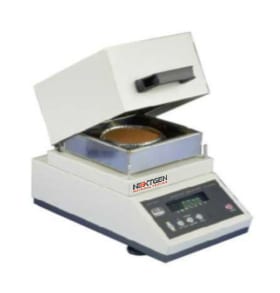
Moisture Determination Balance - GenMoist
GenMoist is designed to automatically and simultaneously dry and weight a solid sample for the determination of moisture content. The machine provides a continuous direct readout for both the weight and the percentage moisture loss through the entire cycle. It has a build-in timer.
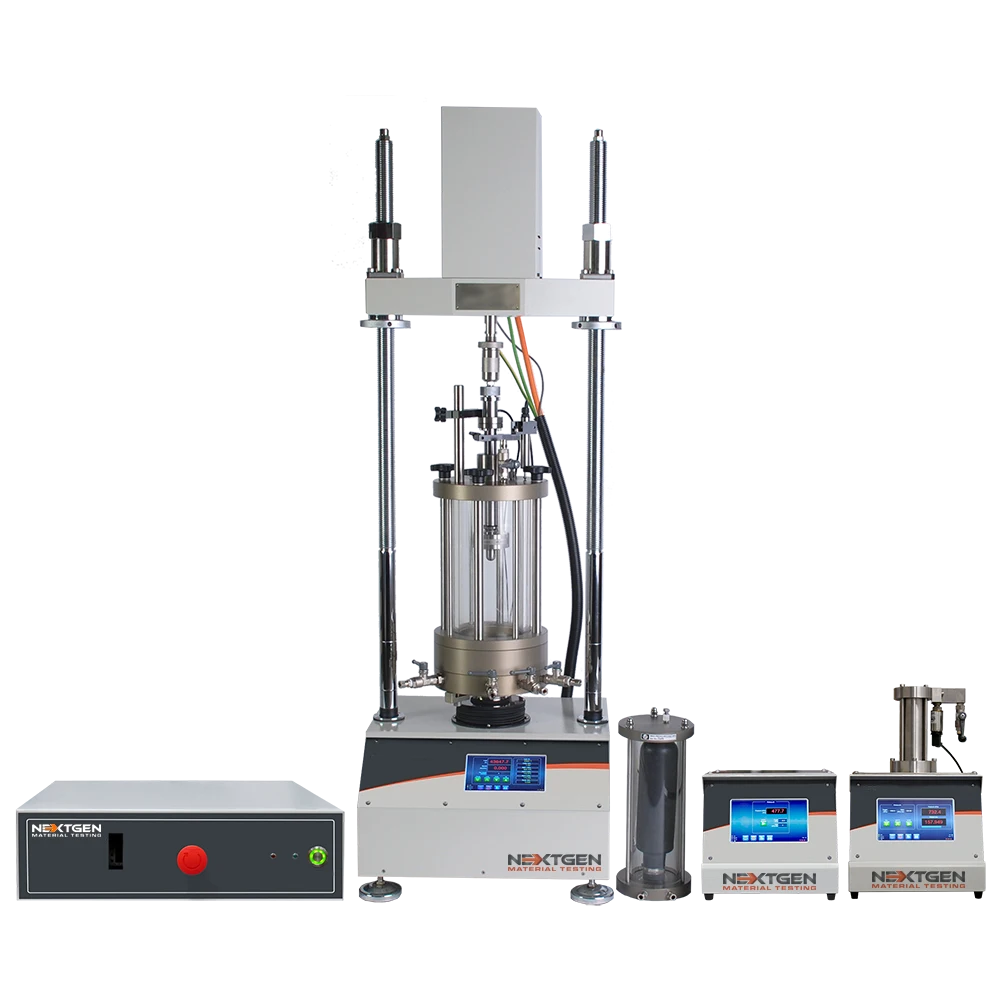
Dynamic Triaxial Systems 1000 kPa
Dynatriax systems are ideal for commercial and research laboratories for the following applications: Liquefaction potential, Strength degradation due to cyclic loading, Shear modulus and damping ratio, resilient modulus, Effects of blasting in mines and quarries, Effect of ocean waves on costal and off shore structures.
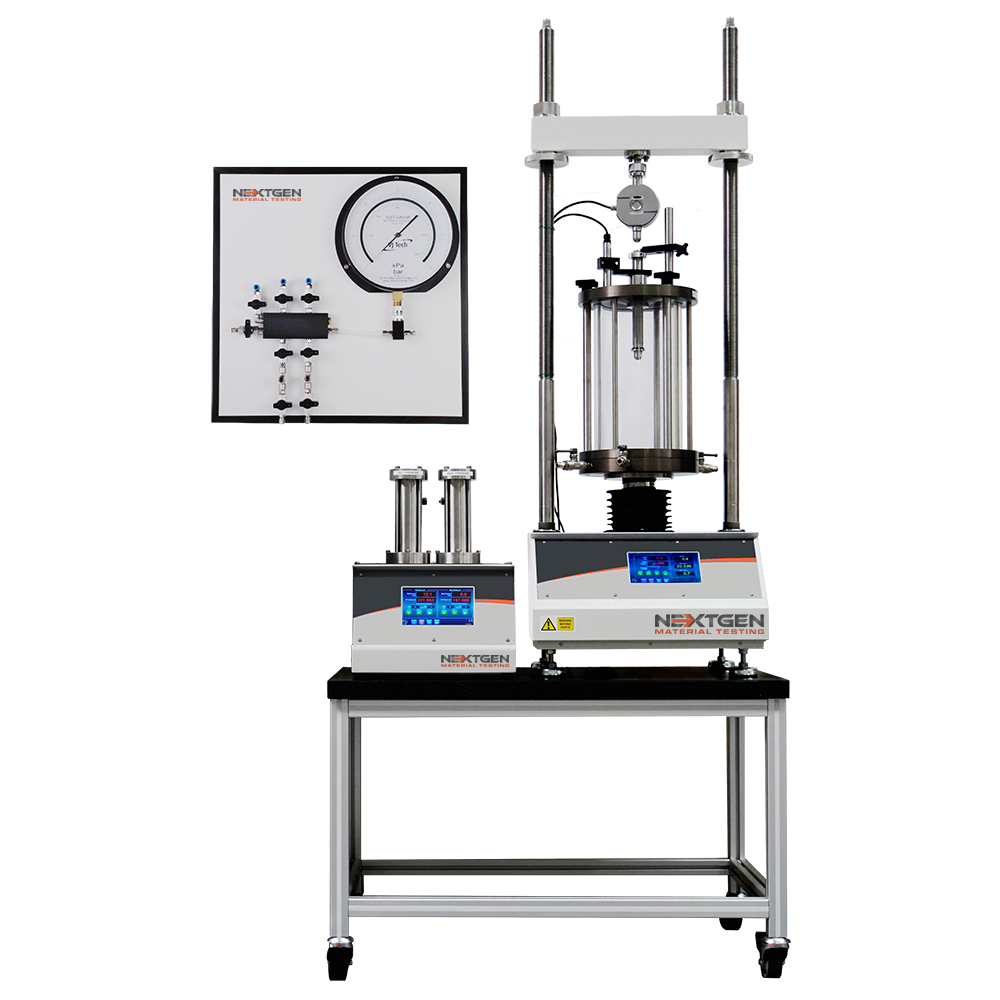
Automatic Triaxial Testing System
Automatic Triaxial Testing System for soil mechanics laboratory testing in compliance with the latest industry standards.
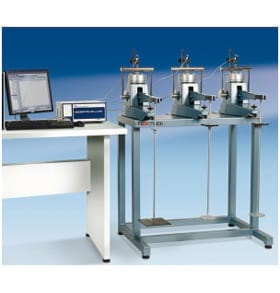
NG-Oedometer - Front Loading Oedometers - Consolidation Test
This test determines the rate and magnitude of consolidation of a soil specimen restrained laterally and subjected to a number of successive increments of vertical loads.

ACE - Automatic Computerized Oedometer
ACE - is the most advanced automatic computerized oedometer for testing soil consolidation that can measure the response of soil specimens.
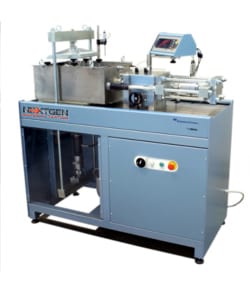
Shearmatic 300 - Large Shear Testing Machine
The SHEARMATIC 300 automatic machine is ideal for testing geosyntetics and also soil and other materials that contain large particles of up to 20 mm largest dimension. Sample size up to 300 mm square can be tested, with inserts allowing the testing of smaller sample sizes. See accessories.
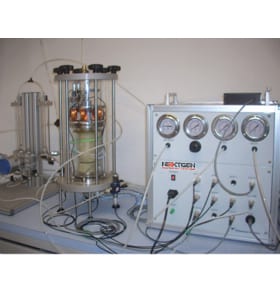
Resonant Column and Torsional Shear Tester
RESONANT COLUMN combines the features of both resonant column and torsional shear into a single unit including the current driven motor to apply torsional load to sample, a series of transducers with signal conditioning, a cell and back pressure electro-pneumatic control system and a data logger.
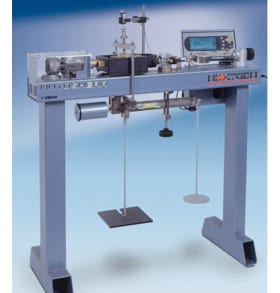
Automatic Shear Testing Machine
The microprocessor control system, therefore, allows the machine to work as an automatic stand-alone unit: the test measurements (force and displacements) a re directly displayed and stored in memory according to pre-set recording modes. The PC is only temporary required to download the test data via the RS 232 port once the test is completed. The data can be processed by the Direct and residual shear Geo-Analysis templates. See accessories.
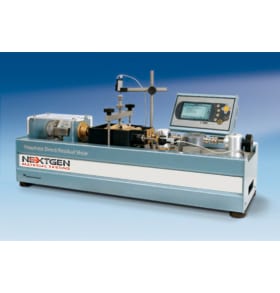
Shearmatic - Automatic Shear Testing Machine
This microprocessor based advanced model, is a stand-alone machine, driven by a high-resolution stepper motor with epicyclical reduction gear with reduced backlash. Incorporate a pneumatic closed loop system for the automatic application of the axial pressure by a high performance pressure regulator, with the main advantage of eliminating the manual loading of the dead weights. Excellent and high resistance techno-polymeric material has been adopted for the carriage of the shear box. It offers excellent resistance to corrosion, wear and tear and is resistant to all chemicals found in a soil specimen. The carriage is lightweight and easy to clean.
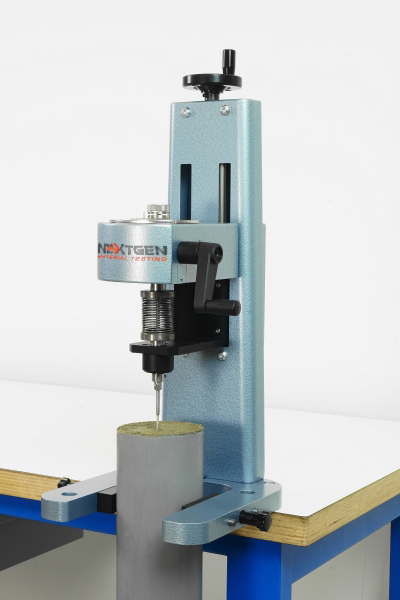
Laboratory Vane Apparatus
The laboratory vane apparatus is based on an original concept of the Transport and Road Research Laboratory of the United Kingdom. It offers versatility with a variety of vane sizes available. Typically it comes with the standard 12.7 mm square vane along with a set of four calibrated springs. Testing can be conducted either directly on the sample or within the sampling tube. For the latter, the NG-WF1738 Attachment for 38 and 100 mm diameter sampling tubes is recommended for optimal performance.